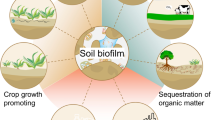Abstract
The effects of water pollution on fungi inhabiting submerged organic debris were investigated. A total of 35 species representing 20 genera were isolated from materials collected from clean and polluted localities. Fewer fungi were obtained from the polluted localities where even common fungi such as penicillia, Curvularia and Trichoderma were less frequently encountered. Organic water pollution was seen to affect not only the abundance of species, but also species distribution.
Similar content being viewed by others
References
Bärlocher, F. & Kendrick, B., 1976. Hyphomycetes as intermediaries of energy flow in streams. In: Gareth Jones, E. B., Ed. Recent advances in aquatic mycology. Paul Elek (Sci. Books) ltd.
Bishop, J. E., 1973. Limnology of a small Malayan river, Sungei Gombak, Dr W. Junk, B.V. Publishers, The Hague.
Cooke, W. B., 1970. Our mouldy earth. U.S. Dept. Int., Fed. Wat. Poll. Contr. Admin., Adv. Waste Treat. Res. Lab., Cincinnati.
Greathead, S. K., 1961. Some aquatic hyphomycetes in South Africa. J. South Afr. Bot. 27: 195–228.
Ho, S. C., 1974. The ecology of a lowland stream, Sungei Renggam, with special reference to pollution. M.Sc. Thesis, Univ. Malaya, Kuala Lumpur.
Ingold, C. T., 1959. Submerged aquatic hyphomycetes. J. Quekett Micro. Cl. Ser. 4, 5: 115–130.
Ingold, C. T. & Cox, V. J., 1957. Heliscus stellatus sp. nov. An aquatic hyphomycete. Trans. Brit. mycol. Soc. 40: 155–158.
Institution of Water Engineers, London, 1960. The approved methods for the physical and chemical examination of water.
Johnson D. S., 1967. On the chemistry of fresh waters in South Malaya and Singapore. Arch. Hydrobiol. 63:477–496.
Kaushik, N. K. & Hynes, H. B. N., 1971. The fate of the dead leaves that fall into streams. Arch. Hydrobiol. 68: 465–515.
Noell, J., 1973. Slime inhabiting geo-fungi in a polluted stream (Winter/Spring). Mycologia 65:57–66.
Nonnis, R. C. & Charton, J. I., 1962. A chemical and biological survey of the Sungei Gombak. Jabataan Chetak Kerajaan, Kuala Lumpur.
Park, D., 1972. Methods of detecting fungi in organic debris in water. Trans. Brit. mycol. Soc. 58: 281–290.
Sparrow, F. K., 1968. Ecology of freshwater fungi. In: Ainsworth, G. C. and Sussman, A. S., Eds. The Fungi. Vol. III. The Fungal Population. Acad. Press. N. Y., 1968
Suberkropp, K. & Klug, M. J., 1976. Fungi and bacteria associated with leaves during processing in a woodland stream. Ecology 57: 707–719.
Author information
Authors and Affiliations
Rights and permissions
About this article
Cite this article
Tan, T.K., Lim, G. Effects of water pollution on fungi of submerged organic debris. Mycopathologia 82, 121–124 (1983). https://doi.org/10.1007/BF00437342
Issue Date:
DOI: https://doi.org/10.1007/BF00437342




